Mango (Mangifera Indica) is the most ancient among the tropical fruits and is believed to have originated in the Indo – Burma region. It grows well under tropical and sub-tropical conditions. However, it gives a profitable yield in semi-arid conditions, especially with irrigation. Mango trees are infested with more than 492 species of insects, 26 species of nematodes, and 17 species of mites.
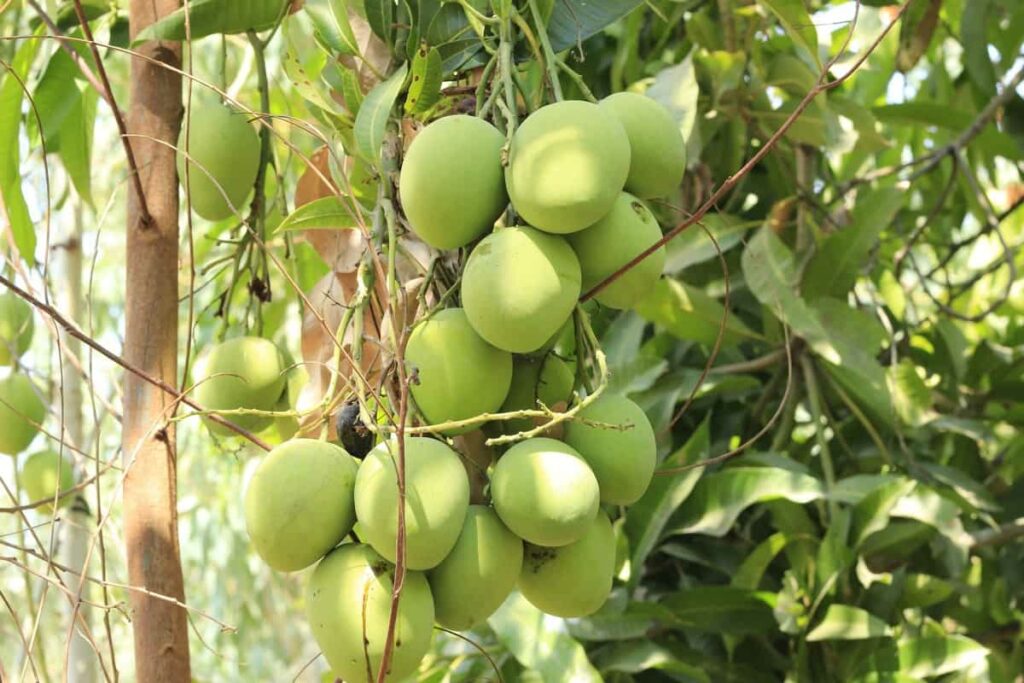
Nearly a dozen of them have been found to cause severe losses to the crop, making them major mango pests. The damage caused by these insects during flowering and fruiting periods is more severe. Simultaneously, Mango suffers from several diseases at all stages of its life. All the parts of the plant, namely, the trunk, branch, twig, leaf, petiole, flower, and fruit, are attacked by many pathogens, including fungi, bacteria, and algae.
As a result, they cause several kinds of rot, dieback, anthracnose, scab, necrosis, blotch, spots, mildew, etc. Additionally, due to its economic importance, powdery mildew causes heavy losses in mango production. Major pests and diseases of mangoes and their control measures are discussed below.
How to control pests and diseases in mango
Mango hopper
The hopper is considered the most serious and widespread pest of all mango pests. These hoppers cause heavy damage to mango crops. The flowering and fruiting period is when females lay the most eggs, and the nymphs grow the fastest. Larvae develop between 12 and 20 days after hatching, and eggs hatch in two to three days. Greenish in color with black or brown markings, nymphs cannot fly and move rapidly on plants. Mango leafhoppers are wedge-shaped insects about 4-5 mm long that are golden brown or dark brown. They fly a short distance, land on the plant, and immediately resettle when disturbed.
Damage symptoms
- The wedge-shaped nymphs and adult insects puncture and suck the sap of tender parts, reducing the vigor of plants and mainly destroying the inflorescence and causing fruit drop.
- Heavy puncturing and continuous draining of sap cause curling and drying of infested tissue.
- They also damage the crop by excreting a sweet sticky substance that facilitates the development of sooty mold
Biological control
- Polynema sp and Mallada boninensis are biological control agents that can reduce hopper populations.
- A spray containing the fungi Beauveria bassiana or Metarhizium anisopliae can also treat affected mango trees. It is recommended to treat at a rate of 2-3 times per week.
- Using sprays containing neem oil (3%) can also reduce Idioscopus spp populations by up to 60%.
Chemical Control
- Three sprays of 0.15 percent Carbaryl or 0.04 percent Monocrotophos or 0.05 percent Phosphomidon or 0.05 percent Methyl Parathion have been very useful in controlling the pest population. As soon as panicles form, the first spray should be applied. After the fruits are set and have reached the pea stage, the second spray should be applied at the full-length stage of panicles but before full bloom.
- Spraying of Nimbicidine (0.2 %) is effective at the initial stage of hoppers management. The chemical spray is to be minimized whenever necessary.
- The insect growth regulator Buprofezin (0.0125 %) is also suggested as one of the sprays.
In case you missed it: High Yield Hybrid Mango Varieties in India: State Wise Growing Guide
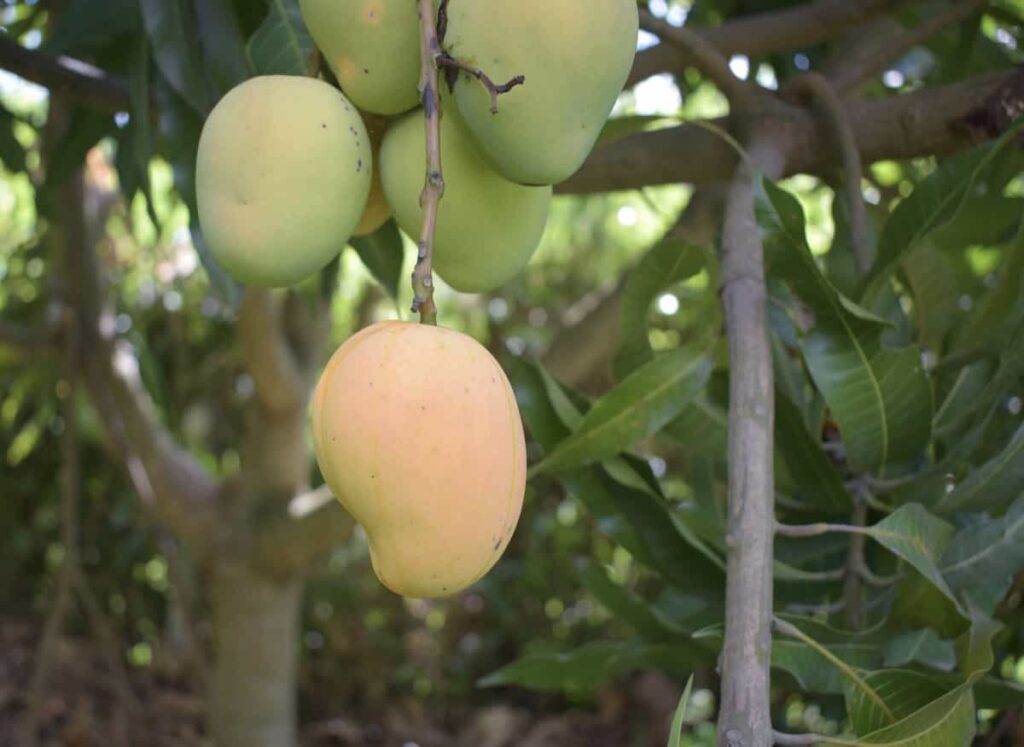
Fruit fly
In recent years, the oriental fruit fly has been one of the country’s most severe pests of mangoes, posing a problem for the export of fresh fruit. A dark brown adult fly measures 7 mm in length and 4 mm across the wings. An ovipositor is located at the end of the female’s tapering abdomen. Pupation takes place in the soil after the larvae have matured. Fruitflies emerge from March onwards, and the maximum population is recorded between April and May when the fruit ripens. From June to July, the population declines slowly, but until March, it is nonexistent.
Damage symptoms
- The female punctures mature fruit walls and insert eggs in small clusters inside the mesocarp using its pointed ovipositor.
- On hatching, the larvae feed on fruit pulp, and the infested fruits start rotting due to further secondary infection
Biological control
- Installation and erection of Traps with Fruit fly pheromone in the orchard from the stage of fruit development until complete harvesting, as well as during a severe outbreak of fruit flies, is necessary for effective prevention and management of fruit fly infestation.
- Traps containing protein baits can be effective for the monitoring and catching of Ceratitis cosyra populations.
- The fungus Metarhizium anisopliae parasitizes the pupae of Ceratitis cosyra on the ground and can be dispersed by hand or as an oil-based spray.
- Post-harvest hot water treatment of the fruits at temperatures above 46 degrees or prolonged storage at 7.5°C or below also destroy the larvae.
Chemical Control
- Bait spray – combing any one of the insecticides and molasses or jaggery ten g/l,
- Malathion 50EC 2 ml/l,
- Dimethoate 30 EC 1 ml/l,
- Carbaryl 50 WP 4 g/l.
Apply two rounds at two weeks intervals before the ripening of fruits. The insecticide with molasses must be applied to the tree trunk. Flies arrive due to the molasses and die.
Bark-eating caterpillar
The adult female emerges in summer and lays 15-25 eggs in clusters under the loose bark of the trees. Spherical eggs, usually singly, eggs hatch in 8-10 days. The larval stage is for ten months. After that, pupation takes place inside the borehole. The full-grown caterpillar is dirty brown and is about 35-45 mm in length. Larvae make webs and feed, making zigzag galleries on the wood filled with frass and excreta and later bores inside the wood. Again, pupation takes place inside the borehole. The pupal stage is 3-4 months.
In case you missed it: Cabbage Farming Business Plan: How to Grow from Seed to Harvest
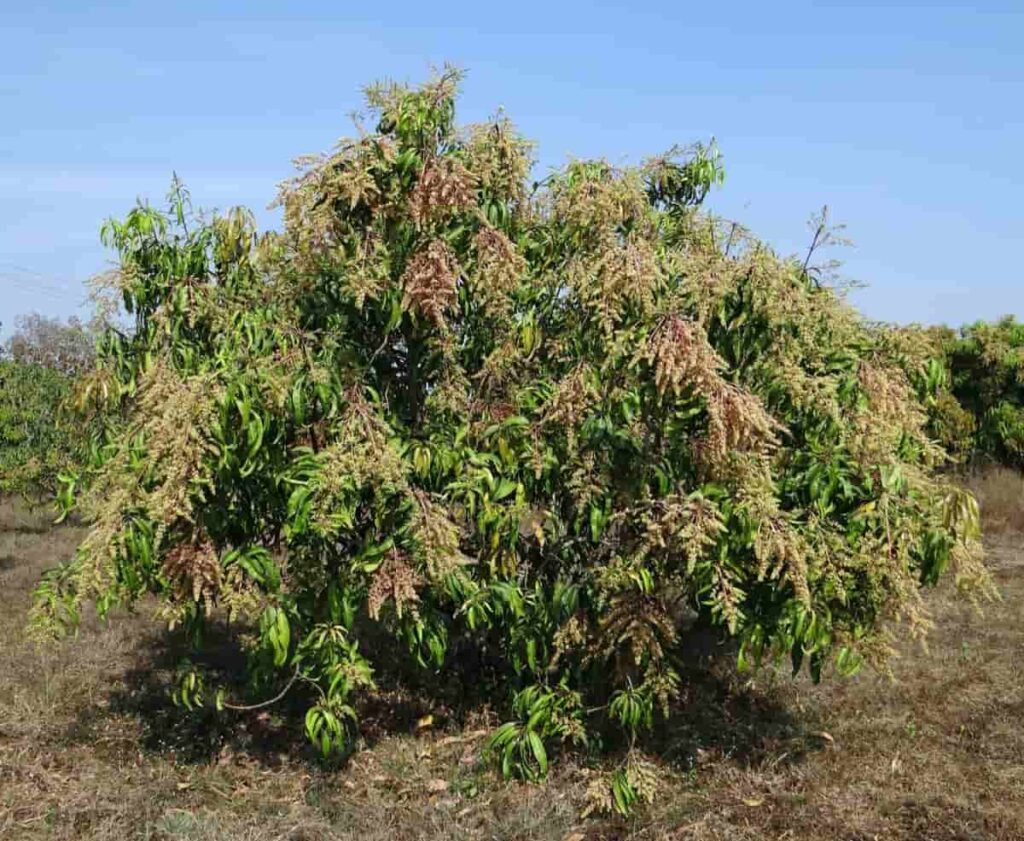
Damage symptoms
- Caterpillars bore into the trunk or junction of branches
- Caterpillars remain hidden in the tunnel during day time and come out at night, feeding on the bark.
- Larvae construct galleries and move into them.
- Affected plant show dried galleries on the stem and shoots.
- Webbing consists of wooden frass and fecal pellets of larvae hanging outside the tunnel.
- Heavy infestations retard the tree’s growth and affect the fruit’s yield.
Biological control
- Avoid growing plant varieties susceptible to bark-eating caterpillars.
- Collect and burn the affected branches.
- Kill the caterpillars by inserting an iron spike into the shelter holes.
- Clean the affected portion with a swab of cotton soaked in petrol or kerosene.
- Use a light trap to attract adult moths.
Chemical control
- During September-October, inject 5 ml dichlorvos in the borehole using a syringe and plug the hole with mud.
- Next, place Carbofuran 3G granules at 5 gm per borehole and seal them with mud.
- Pad with monocrotophos at 10ml / tree or swab the trunk with carbaryl 50 WP at 20 gm/lit.
Mealybug
Mealybugs are sucking insects, soft-bodied, oval in shape, and cottony in appearance. Mealybugs are found on leaves, stems, roots, and fruits covered with whitish powder. The Mango mealy bugs suck a large amount of sap from all parts of the tree. Mealybugs are found in a moist warm climate and are a vector for several plant diseases.
As they suck the plant juices, they secrete a waxy layer that protects them. Some mealybugs lay their eggs in the same waxy layer used for protection in quantities 50-100; other species are born directly from the female.
Damage symptoms
- The adult bugs are covered with whitish powder and colonize between the bark of tree trunks, young shoots, and panicles
- The nymphs ascent the trees and settle on inflorescence causing flower drop and affecting fruit set.
- They also excrete honeydew, a sticky substance, which facilitates the development of sooty mold
Biological control
- Rodolia Sumida and Suminius renardi are essential predators in controlling the nymphs.
- In addition, the entomogenous fungus Beauveria bassiana is found to be an effective bioagent in controlling the nymphs of the mealy bug.
- A foliar spray of Verticillium lecanii or Beauveria bassiana 5g/ml per liter of water is effective during highly humid months in reducing the population of mealy bugs.
Chemical control
- In the soil around the trunk, 250 g of Methyl Parathion dust 2 percent or Aldrin dust 10 percent will kill newly hatched nymphs.
- Spraying of 0.05 percent Monocrotophos or 0.2 percent Carbaryl, or 0.05 percent Methyl Parathion has been useful in controlling the mealy bug’s early instar nymphs.
- These sprays can also use to control the mango mealybug (per 10 liters of water),
- Spintoram 25 % w/w
- Sulfoxaflor 50 % w/w at 7.5 ml
- Chlorpyrifos 40% w/v at 50 ml
Mango nut weevil
Mango leafhoppers usually feature a wedge-like shape with a broad, round head and rounded eyes. Adults are golden or dark brown and about 4-5mm long. Nymphs are yellow-brown, with red eyes. Depending on the species, mango hoppers lay their eggs singly in the florets, leaf veins, and leaf lamina. They prefer shade environments with high humidity. Adult hoppers are good fliers and spread rapidly over short distances.
Biological control
- As a biocontrol agent against adults, Oecophylla smaragdina can be used.
- The insect can be killed at various stages of its development on fruits with hot and cold treatments.
Chemical control
- It is possible to achieve successful control by spraying deltamethrin twice, once when the fruit is 2-4 cm in size and again 15 days later.
- These infestations can be effectively controlled with insecticide sprays containing several active ingredients.
In case you missed it: Carrot Farming Business Plan: How to Grow from Seed to Harvest

Mango Diseases and their chemical control
Powdery mildew
Mangoes are prone to powdery mildew, one of the most severe diseases. The characteristic symptoms of the disease are the white powdery superficial fungal growth on leaves, a stalk of panicles, flowers, and young fruits. In addition, rains or mists accompanied by cooler nights during flowering are beneficial for spreading the disease. All of these factors can lead to severe yield losses.
Disease symptoms
- White powdery fungal growth is the characteristic symptom of the disease on leaves, panicle stalks, flowers, and young fruits.
- Affected flowers and fruits drop prematurely, reducing crop yields significantly or preventing fruit sets.
- The fungus parasitizes all parts of the leaves and fruits.
- Young leaves are attacked on both sides, but the grower’s surface is more conspicuous. Patches often coalesce into larger areas and turn purplish brown
Chemical control and management
- Alternate spraying of Wettable sulfur 0.2 percent (2 g Sulfex/liter), Tridemorph O.1 percent (1 ml Calixin/liter), and Bavistin at 0.1 % at 15 days intervals are recommended for effective control of this disease. The first spray should be given at the panicle emergence stage.
- Although dusting sulfur at 10-15 days intervals is effective, the treatment may cause handling hazards and toxicity in hot weather.
- Sprays can achieve adequate control with 0.2 percent wettable sulfur.
Anthracnose
Mangoes are most commonly affected by anthracnose. There are significant losses from flowering to fruit set and again after harvest. During ripening, black spots appear on the fruit’s surface. During periods of wet weather, the disease is most severe. Therefore, pre-and post-harvest control measures are required.
Disease symptoms
- The disease causes severe losses to young shoots, flowers, and fruits. It also affects fruits during storage.
- Blossom blight can range from mild to severe, depending on the weather conditions. As a result, black spots develop on panicles and fruits.
- The severe infection destroys the entire inflorescence resulting in no setting of fruits. Instead, young infected fruits develop black spots, wilt, and drop off.
- When fruit is infected at the mature stage, it carries the fungus into storage and causes considerable losses during storage, transit, and marketing.
Chemical control and management
- Controlling blossom infection can be controlled by spraying Carbendazirn (Bavistin 0.1%) twice at 15-day intervals during flowering.
- Spraying copper fungicides (0.3% w/v) on foliar infections is recommended.
- The post-harvest disease of Mango caused by anthracnose could be controlled by dip treatment of fruits in Carbendazim (0.1%) in hot water at 520C for 15 minutes.
- Dipping fruits in benomyl (500 ppm) and thiabendazole (900 ppm) is enough to achieve reasonable control.
Dieback
Mango dieback is one of the most severe diseases. You may notice the disease on the tree at any time of year, but it is most noticeable in October and November. Trees with the disease display a scorched appearance due to the drying of twigs and branches, followed by complete defoliation. Discoloration and darkening of the bark are the first signs.
Along leaf veins, the dark area advances and extends outward. As a result, the margins of the affected leaf roll upwards and turn brown. During this stage, the twig or branch dies, shrivels, and drops its leaves. It may also be accompanied by yellowish-brown gum exudation.
Disease symptoms
- The disease is most conspicuous during October and November.
- It is characterized by the drying back of twigs from top downwards, particularly in older trees, followed by the drying of leaves which gives an appearance of fire scorch.
- Wood tissue slit open along its long axis will show internal browning.
- Cracks appear on branches, and gum exudes before they die out. When the graft union of a nursery plant is affected, it usually dies
Chemical control and management
- Measures such as the sterilization of budding knives, placement of budded trees in a dry environment, and gradual exposure to full sunlight have been suggested to control the dieback of grafted seedlings.
- The disease can be controlled by pruning diseased twigs 2-3 inches below the affected portion and spraying Copper Oxychloride (0.3%) on infected trees. Copper Oxychloride (0.3%) is pasted on the cut ends of pruned twigs.
In case you missed it: Shrimp Farming Business Plan: Every Aqua Farmer Should Know Before Getting Started
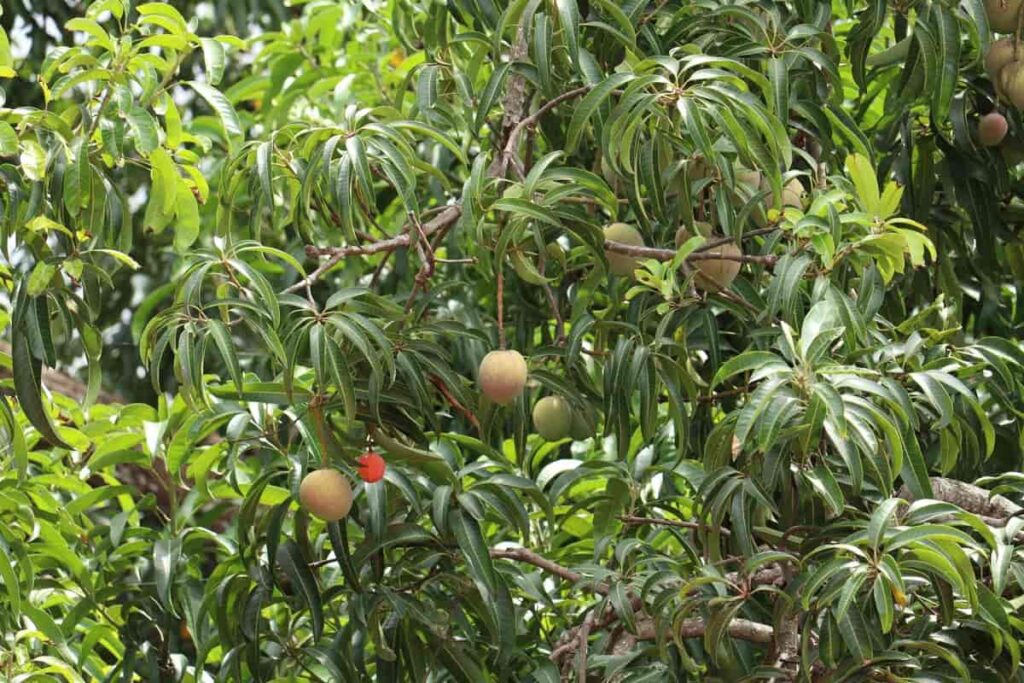
Red rust
There are several pests and diseases which attack the mango tree. One of them is red rust. It’s an algal disease, and the causal organism responsible is Cephaleuros virescens, and it has been observed in mango-growing areas. The disease can be easily recognized by the rusty-red spots, mainly on leaves and sometimes on the bark of young twigs, and is epiphytic. The disease attack causes a reduction in photosynthetic activity. In severe infection, the bark becomes thick, twigs enlarge but remain stunted, and the foliage finally dries up.
Disease symptoms
- Initial green-colored patches characterize the disease. As and when the disease advances, the organism turns rusty red spots on the leaves and young twigs.
- The spots are initially circular, slightly elevated, and later merge to form irregular spots.
- The upper surfaces of the spot consist of numerous, unbranched filaments, which project through the cuticle.
- Some of the filaments represent sterile hairs, while others the fertile ones.
- Spores mature, fall off, and leave the cream-to-white velvet texture on the leaf’s surface.
Chemical control and management
- Three sprays of Streptocycline (0.01%) or Agrimycin-100 (0.01%) after the first visual symptom at 10-day intervals and monthly sprays of Carbendazim (0.1%) or Copper Oxychloride (0.3%) are effective in controlling the disease.
- Injections of copper sulfate and 2, 4-D to the infected branches or a spray of 30-40 percent diesel oil emulsion in soap water can also eradicate the parasite.
Sooty mold
Mango sooty mold is a species of fungi that grow on honeydew resulting from interactions among sap-feeding insects such as soft scale (wax, green and cottony cushion scales), mealybugs, aphids, whiteflies and treehoppers, and non-parasitic fungi. The fungi leave some cosmetic damage on the tree and do not infect the plant tissue. However, they negatively impact plant photosynthesis and growth by blocking sunlight from reaching leaf chloroplasts.
In case you missed it: Terrace Gardening ideas for Home in India: For Vegetables, Fruits, Flowers, and Herbs
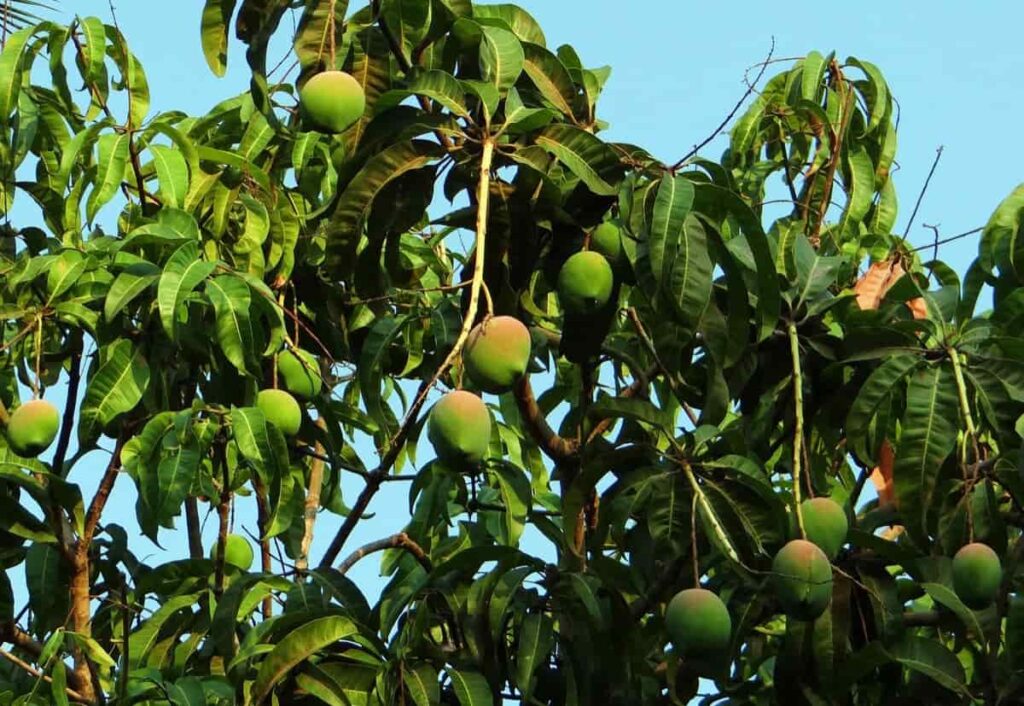
Disease symptoms
- The disease in the field is recognized by the presence of a black velvety coating, i.e., sooty mold on the leaf surface.
- In severe cases, the trees turn completely black due to mold over the entire surface of twigs and leaves.
- The severity of infection depends on the honeydew secretion by the insects. Honeydew secretions from insects stick to the leaf surface and provide the necessary medium for fungal growth.
Chemical control and management
- Pruning of affected branches and their prompt destruction, followed by spraying of Wettasulf (0.2% )+ Metacid (0.1 %)+ gum acacia (0.3%), helps to control the disease.
- The fungal growth can be checked by spraying with 0.2% wettable sulfur.
- Pruning of affected branches and their prompt destruction prevents the spread of the disease.
- Spraying of 2% starch is found effective.
Conclusion
If you plan to cultivate mangoes commercially, you must be aware of these pests and diseases and have good knowledge of their control methods. The infections should be identified and controlled at the initial stage only to reduce the yield losses.
- How to Raise Pigs in Your Own Backyard: A Comprehensive Guide
- Budget Friendly Sheep Shed Ideas: Cheap and Low-Cost Tips
- How Much Do Cattle Farmers Make: Revenue Streams in Cattle Farming
- Management Pests and Diseases in Your Cotton Field
- Sheep Farming Business Plan for Beginners
- Aquaponic Farming at Home: A Step-By-Step Guide
- Profitable Village Farming Business Ideas in 2024
- High-Yield Aquaculture: Fast-Growing Fish for Farming
- Effective Fish Pond Construction Techniques for Beginners
- Irrigation and Water Management in Pineapple Farming
- Blossom to Harvest: Mastering Flowering and Pollination in Papaya Farming
- Pig Fattening Essentials: From Selection to Sale for Beginners
- Raising Wagyu Cattle: A Complete Guide for Premium Beef Production
- Soil Types and Their Water Holding Capacity
- Optimizing Irrigation Schedules for Coconut Groves for Enhanced Yield
- Espresso Your Garden: Coffee Grounds for Healthier Acid-Loving Plants
- The Best Soil Mix for Snake Plants: How to Mix Your Own Snake Plant Soil
- Green Thumb Success: Expert Tips for Cultivating Greenhouse Beans All Year Round
- Bloom All Year Round: The Ultimate Guide to Indoor Hyacinth Care
- Eco-Friendly Gardening: How to Make Liquid Fertilizer from Kitchen Waste
- Ultimate Guide to Grow Anise in Pots: Explore Seed Propagation to Harvesting
- Guide to Raising Chester White Pigs: Discover Breed Facts to Growth Management
- Mastering the Elegance: The Ultimate Guide to Weeping Cherry Tree Care, Planting, and Maintenance
- Ultimate Guide to Planting Garlic in Grow Bags: Growing Strategies for Beginners
- How to Fix Spider Plant Leaf-Related Problems: Natural and Organic Remedies
- 10 Reasons Why Your Tulsi Plant is Shedding Leaves: Home Remedies and Solutions
- Optimizing Growth and Yield: The Advantages of Palm Bunch Ash Fertilizer
- Utilizing Neem Oil Extract as a Natural Pesticide for Hydrangea
- From Soil to Harvest: Various Ways in Which Farmers Can Use AI Tools
- Steps to Encourage and Induce Citrus Flowers: A Comprehensive Guide
- How to Fix Snake Plant Leaf-Related Issues: Natural and Organic Remedies
- Transform Your Garden into a Fragrant Oasis with Raat Ki Rani (Night Blooming Jasmine)
- Discover the Ideal Chicken Breeds for Philippine Farms
- How to Create a Poultry Egg Farm Business Plan for Profits
- Grow Lemon Cucumbers Like a Pro: Insider Techniques for Bountiful Yields
- Ultimate Guide to Caring for Your Pink Princess Philodendron: Tips for Thriving Variegation
